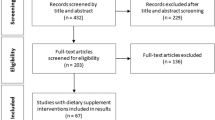Abstract
The goal of this randomized, double-blind crossover clinical trial in 50 healthy volunteers sensitive to acidic foods was to evaluate whether Ester-C® calcium ascorbate causes fewer epigastric adverse effects than are produced by regular ascorbic acid (AA). Volunteers were randomly separated into 2 groups of 25. The study comprised an observation period of 9 days (phase 1 medication for 3 consecutive days, washout phase for 3 consecutive days, phase 2 medication for 3 consecutive days). Participants took 1000 mg vitamin C as Ester-C during phase 1 of the study followed by 1000 mg of vitamin C as AA during phase 2, or vice versa. During the course of the study, 3 examinations for the evaluation of epigastric adverse effects were performed (on days 0, 3, and 9). Participants used a diary to record epigastric adverse effects on a daily basis. In total, 28 (56%) of 50 participants reported 88 epigastric adverse effects of mild to moderate intensity. Of these 88 adverse effects, 33 (37.5%) occurred after intake of Ester-C and 55 (62.5%) were noted after intake of AA. The tolerability of Ester-C was rated “very good” by 72% of participants, whereas AA was rated “very good” by only 54%. This difference is statistically significant (P < .05). Investigators concluded that Ester-C compared with AA caused significantly fewer epigastric adverse effects in participants sensitive to acidic foods and that Ester-C is much better tolerated.
Similar content being viewed by others
References
Weber P. Vitamin C. In: Biesalski H-K, Köhrle J, Schürmann K, eds.Vitamine, Spurenelemente und Mineralstoffe. Stuttgart, New York: Thieme Verlag; 2002: 57–69.
Hemila H. Vitamin C intake and susceptibility to the common cold.Br J Nutr. 1997; 77: 59–72.
Hemila H. Vitamin C and common cold incidence: a review of studies with subjects under heavy physical stress.Int J Sports Med. 1996; 17: 379–383.
Hemila H. Vitamin C and the common cold.Br J Nutr. 1992; 67: 3–16.
Hemila H, Herman ZS. Vitamin C and the common cold: a retrospective analysis of Chalmers’ review.J Am Coll Nutr. 1995; 14: 116–123.
Audera C, Patulny R, Sander B, Douglas R. Mega-dose vitamin C in treatment of the common cold: a randomized controlled trial.Med J Aust. 2001; 175: 359–362.
Van Straten M, Josling P. Preventing the common cold with a vitamin C supplement: a doubleblind, placebo-controlled survey.Adv Ther. 2002; 19: 151–159.
Hendler SS, Rorvik D, eds. Vitamin C. In:PDR for Nutritional Supplements. Montvale: Medical Economics Company; 2001: 486–498.
Wright JV, Suen RM, Kirk FR. Comparative studies of “Ester C” versus L-ascorbic acid.Int Clin Nutr Rev. 1990; 10: 7–10.
Bush MJ, Verlangieri AJ. An acute study on the relative GI absorption of a novel form of calcium ascorbate.Res Commun Chem Pathol Pharmacol. 1987; 57: 137–140.
Verlangieri AJ, Fay MJ, Bannon AW. Comparison of the anti-scorbutic activity of L-ascorbic acid and Ester C® in the non-ascorbate synthesizing osteogenic disorder shionogi (ODS) rat.Life Sci. 1991; 48: 2275–2281.
Fay MJ, Verlangieri AJ. Stimulatory action of calcium L-threonate on ascorbic acid uptake by a human T-lymphoma cell line.Life Sci. 1991; 49: 1377–1381.
Fay MJ, Bush MJ, Verlangieri AJ. Effect of aldonic acids on the uptake of ascorbic acid by 3T3 mouse fibroblasts and human T lymphoma cells.Gen Pharm. 1994; 25: 1465–1469.
Author information
Authors and Affiliations
Rights and permissions
About this article
Cite this article
Gruenwald, J., Graubaum, HJ., Busch, R. et al. Safety and tolerance of Ester-C® compared with regular ascorbic acid. Adv Therapy 23, 171–178 (2006). https://doi.org/10.1007/BF02850358
Issue Date:
DOI: https://doi.org/10.1007/BF02850358




